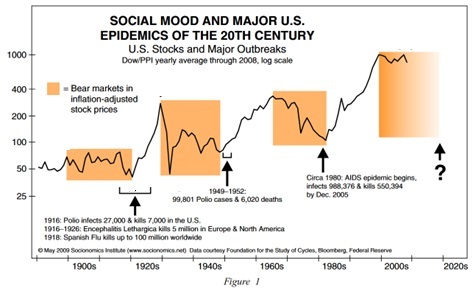Knowing why is the best medicine
The news is in constant flux, but these are the facts as of Feb. 28: Texas is experiencing its worst measles outbreak in 30 years, including the first pediatric measles death in 22 years. Measles cases have now been reported in New Mexico, Alaska, New Jersey, Georgia, New York, and counting — and is more contagious than “just about any other infectious disease” including Ebola and smallpox. (Feb. 28 NPR)
Rather than add to the confusion and fearmongering, we want to provide clarity into why a deadly measles outbreak is occurring now. Here, we revisit the timeless, two-part report “Socionomic View into Epidemic Disease” in the March and April 2009 Socionomist.
Social Mood and Epidemics
The first step toward preparing for the increased risk of disease is to understand the engine that drives it.
The fact is that epidemics and pandemics seem to hit populations during major negative social mood trends. Perhaps it happens that way because people’s psychological constitutions are weaker during bear markets. Perhaps it is because people’s personal behavior, whether involving hygiene (as in the time of the plague or in recent years with respect to hypodermic needles used to inject drugs) or sexual promiscuity, is more conducive to spreading disease during social mood retrenchments. Perhaps it is because social mood retrenchment brings economic contraction, which makes people less able to afford the creature comforts that ward off disease and more apt to crowd into smaller, more affordable spaces.
In other words, the mechanisms may be complex, but the ultimate driver is social-mood change, which in turn leads to changes in social behavior and perhaps in individuals’ constitution.
Figure 1 is a chart of inflation-adjusted U.S. stock prices dating from 1888… We are about ten years into the current bear market [in stocks measured in gold]. Social stress is rising as we approach another of these dangerous junctures, far bigger than the previous three. It should bring one or more epidemics and, could culminate in a pandemic.

That question mark was answered in March 2020, with the Covid Pandemic, the world’s deadliest pandemic since the 1918 Spanish flu. Since then, outbreaks of measles (and other re-emerging infectious diseases like tuberculosis, dengue, and old flu strains) have been increasing.
Knowing that negative social mood is the larger factor, you can be empowered to take every necessary step to minimize your and your loved one’s risk of illness. The April 2009 Socionomist contributes its own, multi-page game plan on staying safe, including:
Prevention is the best cure. Immunize your family. Wash your hands frequently. Exercise. Maintain good sanitation around your home.
Be prepared for an extended stay at home should quarantines go into effect. Buy storable food and other supplies in advance.
Selectively build community. In bear markets, people desire to belong to smaller groups, and you should not fight this trend. Ties with a close circle of friends create a safety net.
Read the entire two-part report in the March and April 2009 Socionomist with a Socionomics Membership. It includes instant access to our complete library of “Best-Of” issues dating back to July 2004.
Or subscribe to our FREE Socionomics ezine and get “On Our Radar” bulletins straight to your inbox each week.
